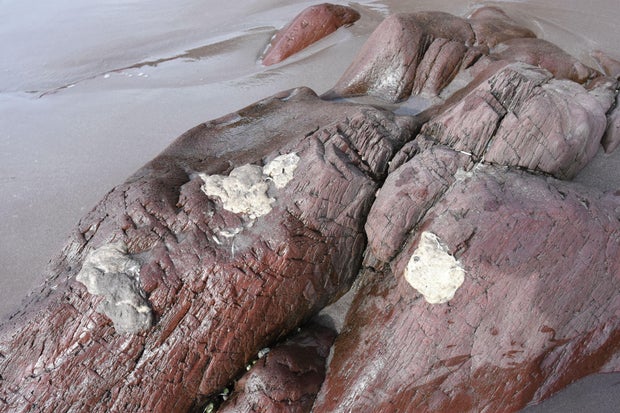CBS News
White blobs washing up on Newfoundland beaches stump experts and worry resident beachcombers

Toronto — Beaches across Canada’s far northeast Newfoundland and Labrador province have increasingly been littered with mysterious white blobs. Their appearance has so far befuddled scientists, and led Canadian officials in the region to launch an investigation.
Beachgoers first noticed the unusual blobs on the shores of Newfoundland and Labrador in September. People quickly started sharing photos of the gelatinous clumps on a Facebook group with more than 40,000 members that is dedicated to exploring the region’s coastal areas.
“Anyone know what these blobs are. They are like touton dough and all over the beach,” wrote Philip Grace on the Beachcombers Facebook group, comparing the finds to a regional dish. “These were in sizes ranging from dinner plate size right down to a toonie [Canadian 2-dollar coin].”
Some people speculated online that the mystery blobs could be the result of ships dumping substances into the ocean. Others suggested they could be whale sperm, whale vomit or even ambergris, a byproduct of sperm whales that’s valued for its use in perfumes and other products.
Environment and Climate Change Canada
But the experts weren’t to be dragged into the speculation.
Environment and Climate Change Canada, the government agency responsible for investigating the mystery, simply referred to the blobs as “a mystery substance” when asked by CBS News on Tuesday.
Newfoundland resident David McGrath told The Guardian newspaper that he’d seen hundreds of the items scattered across his local beaches.
“They looked just like a pancake before you flip it over, when it has those dimpled little bubbles. I poked a couple with a stick and they were spongy and firm inside,” he told the newspaper. “I’ve lived here for 67 years, and I’ve never seen anything like this. Never.”
Environment and Climate Change Canada
“They sent the Coast Guard over and I asked them how bad it was. They told me they had 28 miles of coastline littered with this stuff and had no idea what it was,” McGrath said. “Is it toxic? It is safe for people to touch?”
Samantha Bayard, a spokesperson for Environment and Climate Change Canada, told CBS News the agency was first informed about the “mystery substance” on beaches on Sept. 7. Environmental emergency officers visited sites at least three times to assess the situation and collect samples.
“To date, ECCC has conducted several aerial, underwater and manual surveys of the beaches and shorelines in the area to determine the extent of the substance, what it is and its potential source,” she said. “At this time, neither the substance nor its source has been identified.”
Bayard said a preliminary laboratory analysis by the agency suggested the material “could be plant-based,” but stressed that additional analysis was required “before a final determination can be made on the substance and its potential impacts.”
Stan Tobin, a local environmentalist, told CBS News’ partner network BBC News that he’d found “hundreds and hundreds of blobs — big blobs, little blobs.”
“Somebody or somebodies know where this came from and how it got there, and knows damn well it’s not supposed to be here,” Tobin told the BBC.
Bayard said the ECCC was committed to addressing pollution incidents and environmental threats with urgency.
“If enforcement officers find evidence of a possible violation of federal environmental legislation, they will take appropriate action in accordance with the applicable Compliance and Enforcement Policy,” she told CBS News.
CBS News
12/18: The Daily Report – CBS News

Watch CBS News
Be the first to know
Get browser notifications for breaking news, live events, and exclusive reporting.
CBS News
Teacher, student killed in Wisconsin school shooting identified

A teacher and student killed in a shooting earlier this week at a school in Madison, Wisconsin, were identified Wednesday by authorities.
The Dane County Medical Examiner’s Office said in a news release provided to CBS News that 42-year-old Erin West and 14-year-old Rubi Vergara were fatally shot Monday morning at Abundant Life Christian School.
Preliminary examinations determined the two died of “homicidal firearm related trauma.” Both were pronounced dead at the scene, the medical examiner said.
An online obituary on a local funeral site stated Vergara was a freshman who leaves behind her parents, one brother, and a large extended family. It described her as “an avid reader” who “loved art, singing and playing keyboard in the family worship band.”
West’s exact position with the school was unclear.
The medical examiner also confirmed that a preliminary autopsy found that the suspected shooter, 15-year-old Natalie Rupnow — a student at the same school — was pronounced dead at a local hospital Monday of “firearm related trauma.” Madison Chief of Police Shon F. Barnes had previously told reporters that Rupnow was pronounced dead while being transported to a hospital.
Police had also previously stated that she was believed to have died from a self-inflicted gunshot wound.
The shooting at the private Christian K-12 school was reported just before 11 a.m. Monday. In addition to the two people killed and the shooter, six others were wounded.
Police said the shooting occurred in a classroom where a study hall was taking place involving students from several grades.
A handgun was recovered after the shooting, Barnes said, but it was unclear where the gun came from or how many shots were fired. A law enforcement source said the weapon used in the shooting appears to have been a 9 mm pistol.
and
contributed to this report.
CBS News
Last-minute government funding bill in limbo after opposition from Trump, others

Watch CBS News
Be the first to know
Get browser notifications for breaking news, live events, and exclusive reporting.












